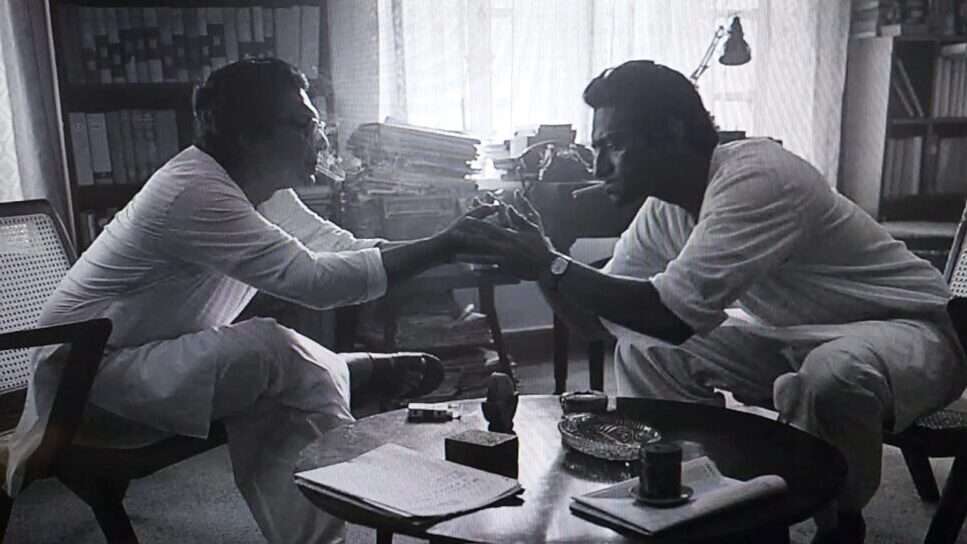Overshadowed by the illustrious Satyajit Ray is another great Indian New Wave director: Mrinal Sen. Padatik, directed by Srijit Mukherji, is a biopic of Mrinal Sen’s life and times, with Chanchal Choudhury playing the lead. In fact, it’s high time there was an homage to the underappreciated Sen. The biopic had its European premiere at the autumnal programme of the London Indian Film Festival 2023, an apt film to bring the festival to a close. It included a post-screening Q&A with Mukherji and Choudhury, dressed in a manner to combat the near-freezing temperatures of England’s autumn, no doubt a rare and probably unpleasant experience for anyone visiting from the sunny Indian subcontinent.
Padatik, which means ‘guerrilla fighter’ or ‘foot soldier,’ is named after Sen’s third film in his iconic ‘Calcutta Trilogy.’ It sets out to unveil Sen’s life from his early adult life until his old age and after his wife, Gita Sen, an actress who appeared in several of his films, passes away. The film opens with depicting Sen as a poor student, talking with his like-minded bookish friends about the burgeoning crisis of class and poverty in Kolkata. His aspirations to become a filmmaker are clearly tied to his political leanings towards active socialism. We see many moments of despair in his younger years, when the harsh reality of ‘making it’ in an increasingly dog-eat-dog world forces Sen to take up a job as a medical representative, much to his chagrin.
Padatik depicts his struggles between wanting to heed his true calling for film and, on the other hand, what he must do to survive. Sen struggles to get by, and at various points, he is shown as unable to even buy a small sack of rice for himself and his wife (played by Monami Ghosh). As his career develops, we see much less of this poverty, which is often the subject matter of his films. Chanchal Choudhury does a fantastic job at portraying Mrinal Sen, not least because he appears to be a spitting image of the director but also because he imbibes the particular mannerisms and the slight air of self-importance surrounding Sen very well.
At the Q&A, Choudhury talked about the sad loss of his father just before he was due to start filming Padatik. The actor was vigilant to check whether there were any emotional signs of his bereavement in his expressions when it came to reviewing the footage. He also spoke with reverence about his great responsibility to do justice to the role of playing such an iconic man as Mrinal Sen.

Mukherji discussed the making of Padatik as arising from a desire to counteract the amnesia around Sen’s work, pointing to the fact that no single street in Kolkata is named after the great director, despite his contributions to the city and country. Mukherji explained the weight he placed on ensuring Sen’s life was shown as accurately as possible. While writing the script, he extensively researched Sen’s journals, articles, essays, and letters. Moreover, he reached out to those who knew him well, none more so than Sen’s only son Kunal, who, in parallel to the production of Padatik, was separately writing a memoir of Sen in ‘Bondhu: My Father, My Friend,’ a book that has since been published.
Mukherji tries to draw parallels in Padatik with similar scenes in Sen’s movies by using Sen’s characteristically unconventional filmmaking styles. Such Sen-esque styles include the prolific use of breaking the fourth wall, jump cuts, freeze frames, and chiaroscuro imagery. However, Mukherji’s deployment of some of these techniques does not feel as well-crafted and meaningful as when we see them in Sen’s own films (a great example of which can be found in The Interview, the first of Sen’s Calcutta Trilogy). It appears a little clumsy and hastily done without sufficient time to explore the details of the political fervor of that era, which so heavily informed Sen’s work. When the film shows glimpses of the sociopolitical landscape in which Sen lived, the references to them are merely frivolous and so fall short of providing more context for the viewer.
What is conjured quite well, however, are the scenes where we see Mrinal Sen and Satyajit Ray together, which certainly adds an extra layer of interest to the film. Ritwik Ghatak is also briefly depicted, satisfyingly completing the ‘holy trinity’ of the Indian New Wave directors: Ray, Ghatak, and Sen. In the parts where Sen and Ray interact, Ray is mostly seen reclining in his chair with a cigarette in hand, exuding nonchalance while talking about matters of art and film with Sen, and often pointedly discussing the flaws of each other’s filmmaking.
The pair infamously clashed on several fronts, but Mukherji brings out the nuances of this long-held public perception of the two maestros, and we see instead what is, perhaps, tough love and mutual respect for each other. The depiction of these two bastions of parallel cinema sitting together and casually debating one another’s art induces a sense of nostalgia for this bygone era of nascent alternative filmmaking, which sprung up boldly from the ashes of social injustice, intellectualism, and a desire to challenge the status quo.
Mukherji explains at the Q&A, “Sen’s storytelling is raw, without polish, and not for the comfortably numb.” Indeed, Sen’s films are intentionally hard-hitting, jarring, and designed to rattle the viewer to jolt them awake to reality rather than provide them with cinematic escapism. Padatik achieves its purpose of shaking off the dust on a great legend that deserves more remembrance. It is a tribute to the gift of Sen’s unique style of filmmaking, which compels you to engage with cinema differently and to join the dots between that and the complexities of the society in which you live.



![Blindspotting [2018] Review: Change The Way You See](https://79468c92.delivery.rocketcdn.me/wp-content/uploads/2019/01/blindspotting-screenshot-2-768x414.jpg)
![Bhavesh Joshi Superhero Review [2018]: Not a Great, but an Important Film](https://79468c92.delivery.rocketcdn.me/wp-content/uploads/2018/09/Bhavesh_Joshi_Superhero-768x326.png)



